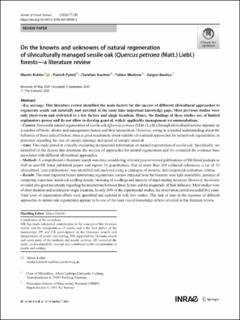| dc.description.abstract | Key message This literature review identified the main factors for the success of different silvicultural approaches to regenerate sessile oak naturally and unveiled at the same time important knowledge gaps. Most previous studies were only short-term and restricted to a few factors and single locations. Hence, the findings of these studies are of limited explanatory power and do not allow to develop general, widely applicable management recommendations. Context Successful natural regeneration of sessile oak (Quercus petraea (Matt.) Liebl.) through silvicultural actions depends on a number of biotic, abiotic and management factors and their interactions. However, owing to a limited understanding about the influence of these critical factors, there is great uncertainty about suitable silvicultural approaches for natural oak regeneration, in particular regarding the size of canopy openings and speed of canopy removal. Aims This study aimed at critically evaluating documented information on natural regeneration of sessile oak. Specifically, we identified (i) the factors that determine the success of approaches for natural regeneration and (ii) evaluated the evidence base associated with different silvicultural approaches. Methods A comprehensive literature search was done considering relevant peer-reviewed publications of ISI-listed journals as well as non-ISI listed published papers and reports by practitioners. Out of more than 260 collected references, a set of 53 silvicultural ‘core publications’ was identified and analyzed using a catalogue of numeric and categorical evaluation criteria. Results The most important factors determining regeneration success extracted from the literature were light availability, presence of competing vegetation, initial oak seedling density, browsing of seedlings and intensity of stand tending measures. However, the review revealed also great uncertainty regarding the interactions between these factors and the magnitude of their influence. Most studies were of short duration and restricted to single locations. In only 20% of the experimental studies, the observation period exceeded five years. Total costs of regeneration efforts were quantified and reported in only two studies. This lack of data on the expenses of different approaches to natural oak regeneration appears to be one of the most crucial knowledge deficits revealed in this literature review. Conclusion Natural regeneration of sessile oak may be achieved under a wide range of canopy openings, if competing vegetation and browsing is negligible, seedling density is high and tending to remove competing vegetation is carried out consistently. However, since the silvicultural regeneration success depends on the interactions among these factors, which have often not been adequately considered, we caution against general recommendations for silvicultural systems developed from case studies and call for new long-term studies with comprehensive experimental designs. | en_US |

